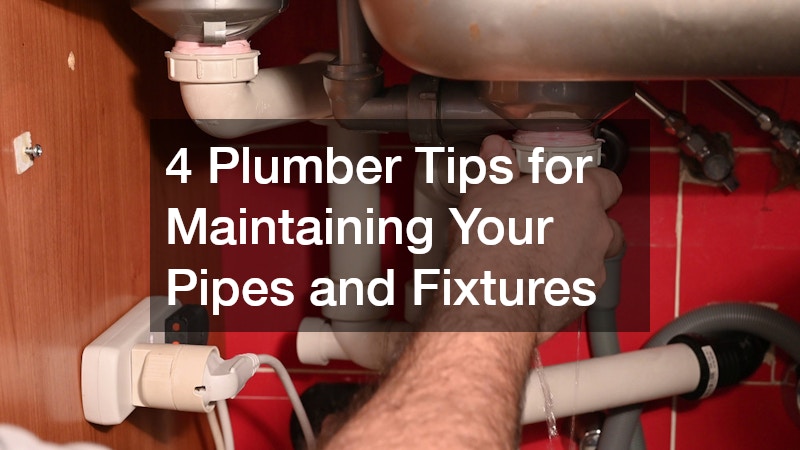A professional plumber knows that regular maintenance can save you time, money and frustration when it comes to keeping your pipes and fixtures in top condition. Many homeowners don’t think about plumbing until something goes wrong, but a few simple habits can help prevent serious problems and protect your property from damage.
Pipes, taps, drains and toilets are all used daily. Without proper care, wear and tear builds up, small leaks go unnoticed and blockages begin to form. You don’t need to be an authority to keep your system running smoothly. These four tips can help you maintain your plumbing and avoid those unexpected calls to an emergency plumber.
Watch what goes down your drains
Clogged drains are one of the most common reasons people need to call a plumber. These blockages don’t usually happen overnight. Instead, they form slowly as substances like grease, soap scum, hair and food particles collect inside your pipes.
In the kitchen, pouring cooking oil or greasy food scraps down the sink is a recipe for trouble. Over time, the grease cools and hardens, sticking to the inner walls of the pipe. The same goes for coffee grounds and fibrous vegetables like celery or pumpkin skins, which can easily get stuck and contribute to blockages.
Hair and soap residue are the usual culprits in bathrooms. Hair easily gets caught in the drain, trapping other debris and forming clumps that slow the water flow. Soap can also leave behind a sticky residue that narrows the pipe over time.
You can prevent many of these issues by using drain strainers and cleaning them regularly. Flushing your drains with boiling water once a week also helps keep them clear. For a deeper clean, try using baking soda and vinegar to break down buildup naturally. Still, if the water starts draining slowly or you notice unpleasant smells, it’s time to contact a plumber to avoid more serious blockages.
Check for leaks early
Leaking taps and pipes are often ignored, especially when the problem seems small. A slow drip or slight damp patch might not feel urgent, but these issues can escalate quickly. If left unresolved, water leaks can damage cabinetry, floorboards and even structural components of your home.
A leaking tap can waste thousands of litres of water a year, adding to your utility bills and placing unnecessary pressure on the environment. In bathrooms, signs of leaks may include loose tiles, bubbling paint or water pooling at the base of the toilet or vanity.
It’s also important to check outdoor taps and garden plumbing. These are often overlooked, but small leaks in your irrigation system or garden hose connections can waste water and soften the soil around your foundations.
A plumber can quickly identify the source of a leak and carry out repairs before the damage spreads. Fixing small problems early is far more affordable than replacing damaged walls or flooring after a major leak has gone unnoticed.
Don’t ignore noisy pipes
Your home’s plumbing system shouldn’t make much noise beyond the usual whoosh of water. If you start hearing banging, knocking, gurgling or whistling sounds, it could indicate a problem. Many older homes in Australia experience water hammer, a common issue where pipes rattle due to sudden pressure changes.
These noises aren’t just annoying—they may also point to unsecured pipes, failing valves or trapped air in the system. Left unresolved, the vibrations can loosen pipe fittings, cause wear at the joints or lead to cracks and eventual leaks.
Gurgling drains might suggest a partial blockage or a venting issue. Whistling taps often indicate worn washers or valves that need replacing. If the noises continue, it’s worth having a licensed plumber inspect the system. They can diagnose the cause, secure any loose pipes and replace failing parts to prevent future damage.
Schedule regular maintenance
Even if your plumbing seems to be working well, that doesn’t mean everything is in perfect condition. Pipes wear down over time, seals break and sediment can build up inside hot water systems. Scheduling a maintenance check every year or two can help catch these issues before they become disruptive.
During a maintenance visit, a plumber will inspect all visible pipes, taps, toilets and drains. They’ll look for leaks, signs of corrosion, blocked vents and issues with water pressure. If you have a water heater, you can flush the tank to remove sediment and check the anode rod to extend its lifespan.
These checks are especially valuable for homes with older plumbing or properties that have undergone renovations. They give a clear picture of the system’s condition and allow you to plan for any upcoming repairs or replacements.
Preventive maintenance also improves water efficiency. A plumber can recommend modern tapware and fixtures that conserve water without compromising performance, helping you reduce your environmental impact and save on bills.
Caring for your pipes and fixtures doesn’t need to be complicated. A few small habits, like watching what goes down your drains and checking for leaks, go a long way in protecting your plumbing system. Being proactive helps prevent emergencies and extends the life of your pipes, taps and appliances.
Whether it’s stopping a leak, clearing a stubborn blockage or conducting a routine inspection, a professional plumber is your best ally in keeping things running smoothly. With the right care and expert support, your plumbing can serve you well for many years to come.



